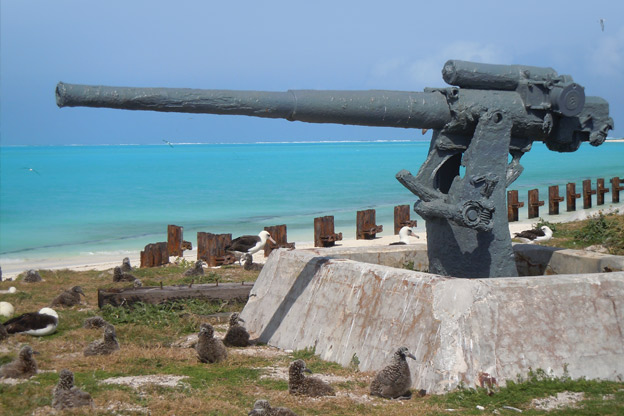The President Moves to Protect the Seas

Ancient WW2 cannons and nesting albatrosses on Midway Atoll, among the few residents of the Papahānaumokuākea Marine National Monument.
Papahānaumokuākea Marine National Monument of Hawaii was established in 2006 by President George W. Bush and was already the largest marine protected area on Earth at 140,000 square miles. President Obama more than quadrupled the monument’s size to 582,578 square miles, an area that is larger than all the other national parks combined and twice the size of Texas. An important element to the move is the complete prohibition of commercial fishing in the area, which will affect the operations of tuna longliners who traditionally operated in those waters. The waters are home to many endangered species including blue whales, short-tailed albatrosses, sea turtles, and the last Hawaiian monk seals. Unidentified species as well as over 7,000 species of corals, including 4,000-year-old black coral, also thrive in the monument.
Around a quarter of the species found in the reserve are found nowhere else, and the corals, some of the most northern, are some of the most likely to survive climate change. The monument represents a whopping 98% of the world’s “no-take” protected ocean, and to call it a game changer may be an understatement.
 The Northeast Canyons and Seamounts Marine National Monument off the coast of Cape Cod is historic as well. It may be a mere 5,000 square miles, about the size of Connecticut yet small compared to Papahānaumokuākea, but it is the first national marine monument in the Atlantic Ocean. This vibrant area of the Atlantic is interesting geologically because it is where the Atlantic Ocean meets the continental shelf. Dramatic canyons deeper than the Grand Canyon, 7,000-foot extinct volcanoes, and a plethora of life including ancient deep sea corals claim this patch of ocean.
The Northeast Canyons and Seamounts Marine National Monument off the coast of Cape Cod is historic as well. It may be a mere 5,000 square miles, about the size of Connecticut yet small compared to Papahānaumokuākea, but it is the first national marine monument in the Atlantic Ocean. This vibrant area of the Atlantic is interesting geologically because it is where the Atlantic Ocean meets the continental shelf. Dramatic canyons deeper than the Grand Canyon, 7,000-foot extinct volcanoes, and a plethora of life including ancient deep sea corals claim this patch of ocean.
The creation of national monuments is a long-standing precedent for the Executive Branch thanks to the Antiquities Act signed into law in 1906 by Republican president Theodore Roosevelt. While the Antiquities Act was originally instituted with the focus to preserve southwestern prehistoric sites, such as burial mounds and cliff-dwellings, from the mining industry, President Roosevelt left office with 18 national monuments under the protection of his pen. These sites include Washington’s own Mount Olympus.
For a global perspective, National Geographic has an excellent interactive graphic to compare nations and their respective number of marine protected areas and percentage of territorial seas protected (ocean.nationalgeographic.com/ocean/take-action/marine-protected-areas/).
The U.S. is faring favorably with 29.39% of seas protected and 750 protected areas. Marine reserves are a growing phenomenon as the conservation efforts of the world are starting to treat the oceans with the same deference that they have treated the land. Will we see more protected areas springing up in our neck of the woods? Where do you think they should be? How will they affect industry? Send us your thoughts and get writing to your representatives. The U.S. park system as been called “America’s best idea.” Perhaps the seas are the new frontier.